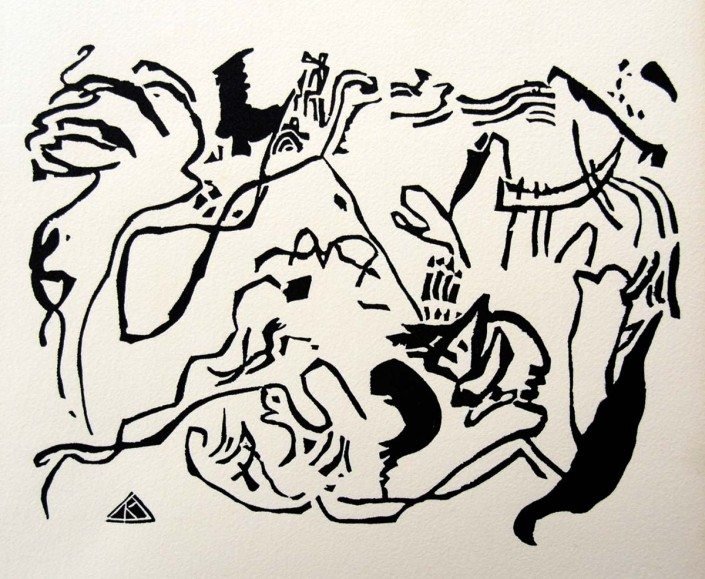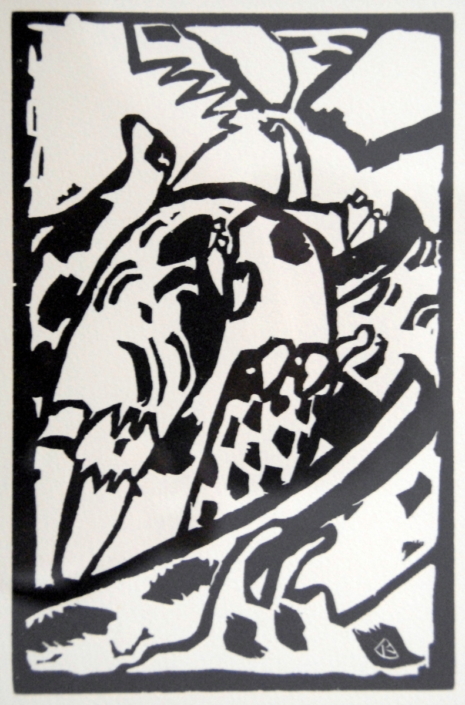Wassily Kandinsky (Moskou 1866 – Neuilly-sur-Seine 1944)
Wassily Kandinsky was een pionier van het modernisme. Zijn stijl ging van gesimplificeerd figuratief via schetsmatige abstracte werken naar pure abstractie. Kleuren riepen bij hem sterke lichamelijke reacties op (synesthesie).
Kandinsky studeerde rechten en economie aan de universiteit van Moskou en was daarna werkzaam als jurist in deze stad. Op dertigjarige leeftijd gaf hij zijn carrière op en vertrok naar München om kunstenaar te worden. Daar studeerde hij eerst twee jaar aan de school van Anton Azbè en daarna aan de Akademie der Bildende Künste. Hij was een van grondleggers van de kunstenaarsgroep de Phalanx en in 1901 werd hij directeur van de Phalanx Malschule. Een van de leerlingen, Gabriele Münter, werd zijn levensgezellin. Na enige jaren door Europa gereisd te hebben streken zij neer in Murnau, waar zij samen schilderden met Alexej von Jawlensky en Marianne von Werefkin. In 1911 was Kandinsky een van de oprichters van de groep Der Blaue Reiter, waaraan o.a. ook von Jawlensky, Münter, Franz Marc en August Macke deelnamen. In 1912 publiceerde Kandinsky zijn theorieën over de psychologische effecten van kleur en klank op de menselijke ziel. Inmiddels was zijn werk volledig abstract geworden, met titels als “improvisatie” en “compositie”. Bij het uitbreken van de eerste wereldoorlog keerde hij zonder Gabriele terug naar Moskou en werkte daar als leraar. Hij trouwde met de 16-jarige Nina de Andrejevski en samen keerden ze na de oorlog terug naar Duitsland, waar Kandinsky in 1922 tot professor benoemd werd aan het Bauhaus in Weimar.
In 1933 werd het Bauhaus door de Gestapo gesloten en moest het echtpaar Kandinsky Duitsland verlaten. Ze verhuisden naar Frankrijk en verkregen in 1939 het Franse staatsburgerschap. Kandinsky stierf op 78-jarige leeftijd in Neuilly-sur-Seine.
Musea onder andere: Hermitage St. Petersburg, National Gallery of Art Washington, Musée National d’Art Moderne Parijs en Guggenheim museum New York.
Wassily Kandinsky was a pioneer of modernism. His style went from simplified figurative via sketchy abstract works to pure abstraction. Colors evoked strong physical reactions in him (synesthesia).
Kandinsky studied law and economics at the University of Moscow and then worked as a lawyer in this city. At the age of thirty he gave up his career and left for Munich to become an artist. There he first studied for two years at the school of Anton Azbè and then at the Akademie der Bildende Künste. He was one of the founders of the artists’ group Phalanx and in 1901 he became director of the Phalanx Malschule. One of the students, Gabriele Münter, became his life partner. After traveling through Europe for a few years they settled in Murnau, where they painted together with Alexej von Jawlensky and Marianne von Werefkin. In 1911 Kandinsky was one of the founders of the group Der Blaue Reiter, in which von Jawlensky, Münter, Franz Marc and August Macke also participated. In 1912 Kandinsky published his theories on the psychological effects of colour and sound on the human soul. In the meantime his work had become completely abstract, with titles such as “improvisation” and “composition”. At the outbreak of the First World War he returned to Moscow without Gabriele and worked there as a teacher. He married the 16-year-old Nina de Andrejevski and together they returned to Germany after the war, where Kandinsky was appointed professor at the Bauhaus in Weimar in 1922.
In 1933 the Bauhaus was closed by the Gestapo and the Kandinsky couple had to leave Germany. They moved to France and obtained French citizenship in 1939. Kandinsky died at the age of 78 in Neuilly-sur-Seine. Museums include: Hermitage St. Petersburg, National Gallery of Art Washington, Musée National d’Art Moderne Paris and Guggenheim Museum New York.




